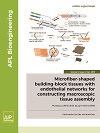
Annual Review of Biomedical Engineering
Scope & Guideline
Advancing the Frontiers of Biomedical Innovation
Introduction
Aims and Scopes
- Biomaterials and Tissue Engineering:
Focuses on the development and application of biomaterials for tissue regeneration, including the engineering of scaffolds and organoids. - Medical Devices and Sensors:
Covers advances in medical devices, including wearable sensors and imaging technologies that enhance patient monitoring and diagnosis. - Drug Delivery Systems:
Explores innovative drug delivery methods, including nanotechnology and microfluidics, aimed at improving therapeutic efficacy. - Regenerative Medicine:
Investigates strategies for tissue repair and regeneration, including stem cell therapy and gene editing techniques. - Bioinformatics and Systems Biology:
Integrates computational methods with experimental data to model biological systems and predict outcomes in biomedical research. - Neuroengineering:
Focuses on technologies and methods for interfacing with the nervous system, including brain-machine interfaces and neuroprosthetics. - Mechanobiology:
Studies the mechanical properties of cells and tissues and their influence on biological processes, particularly in disease contexts.
Trending and Emerging
- Immunomodulation and Biologics:
Recent publications emphasize the role of immunomodulatory therapies and biologics, particularly in the context of autoimmune diseases and transplants, showcasing advancements in personalized medicine. - Advanced Drug Delivery Technologies:
There is a significant increase in research focused on innovative drug delivery systems, particularly those utilizing nanotechnology and microfluidics for targeted therapies. - Artificial Intelligence and Big Data in Healthcare:
The integration of AI and big data analytics into biomedical engineering is gaining momentum, with studies exploring predictive models and personalized treatment strategies. - Wearable and Implantable Sensors:
Emerging trends highlight the development of advanced biosensors that combine implantable and wearable technologies for real-time health monitoring. - 3D Bioprinting and Biofabrication:
An increase in research on biofabrication techniques, including 3D printing of living tissues and organs, reflects a growing interest in regenerative medicine and custom tissue engineering. - Neurotechnology and Brain-Machine Interfaces:
Research in neurotechnology is expanding, focusing on interfaces that enhance communication between the brain and external devices, particularly for rehabilitation and assistive technologies.
Declining or Waning
- Traditional Imaging Techniques:
There has been a noticeable reduction in the publication of papers focused solely on traditional imaging methods, as newer modalities such as photoacoustic and molecular imaging gain traction. - Basic Biomedical Research:
Research purely focused on basic biomedical science without direct engineering applications appears to be waning, as the journal shifts towards more applied engineering solutions. - Conventional Drug Development:
Publications centered around conventional pharmaceutical drug development processes are declining in favor of more innovative approaches such as personalized medicine and targeted delivery systems. - Standard Prosthetics and Orthotics:
The focus on conventional prosthetic and orthotic designs is diminishing, with more attention now on advanced integration and human-machine interactions. - Non-Integrated Healthcare Solutions:
There is a decreasing emphasis on non-integrated healthcare solutions that do not consider the convergence of technology with patient-centered care.
Similar Journals

APL Bioengineering
Advancing Bioengineering for a Healthier TomorrowAPL Bioengineering is a premier open-access journal published by AIP Publishing, dedicated to advancing the field of bioengineering and its interdisciplinary applications. Established in 2017, this journal serves as a vital platform for researchers, professionals, and students interested in the critical intersections of bioengineering, biomaterials, biomedical engineering, and biophysics. With an impressive impact factor and consistent rankings in the Q1 category across multiple domains, including biochemistry and materials science, APL Bioengineering has positioned itself among the top journals in its field. The journal aims to publish innovative original research, comprehensive reviews, and insightful case studies that further the understanding and application of bioengineering principles. Since its inception, APL Bioengineering has fostered a community of thought leaders, providing open access to ensure broad dissemination of knowledge and advancements that underpin the future of biomedical innovation.

Bioengineering-Basel
Exploring the Future of BioengineeringBioengineering-Basel, an esteemed journal published by MDPI, stands at the forefront of innovation in the field of bioengineering since its inception in 2014. With an E-ISSN of 2306-5354, this fully Open Access journal based in Switzerland provides a platform for researchers and professionals to disseminate cutting-edge findings across various aspects of bioengineering, including biomaterials, tissue engineering, and biopharmaceuticals. The journal has been recognized with a Q3 ranking in the 2023 Bioengineering category, reflecting its commitment to quality and relevance. By facilitating widespread accessibility to academic knowledge, Bioengineering-Basel aims to foster collaboration and stimulate thought leadership within the global research community, making it an indispensable resource for students, scholars, and industry practitioners alike.

BIOMEDICAL MICRODEVICES
Bridging Engineering and Biology for Healthier FuturesBIOMEDICAL MICRODEVICES is a leading journal published by Springer that focuses on the innovative field of microdevices within biomedical engineering. With an ISSN of 1387-2176 and an E-ISSN of 1572-8781, BIOMEDICAL MICRODEVICES offers a prestigious platform for researchers to disseminate their findings from 1998 to 2024, demonstrating a long-standing commitment to advancing knowledge in this critical area. The journal is recognized for its significant contributions, boasting a Q2 ranking in Biomedical Engineering and Nanoscience and Nanotechnology, and a Q3 rank in Molecular Biology. Renowned for its rigorous peer-review process, it is positioned within the top 30% of its field according to Scopus rankings, making it a valuable resource for researchers and practitioners alike. Though it operates under a subscription model, the emphasis on quality and relevance within its scope ensures that BIOMEDICAL MICRODEVICES remains a vital source of cutting-edge research that bridges engineering and biological systems, fostering innovation and collaboration in the pursuit of novel health solutions.

Regenerative Biomaterials
Bridging Science and Application in BiomaterialsRegenerative Biomaterials, published by Oxford University Press, serves as a premier platform for the dissemination of innovative research in the rapidly evolving field of biomaterials. Since its inception in 2014, this esteemed open-access journal has fostered a collaborative and diverse scientific community, providing free access to impactful articles that enhance our understanding of regenerative medicine and tissue engineering. With a commendable impact factor and ranking within the top quartiles of both Biomedical Engineering and Materials Science, it is recognized for its rigorous peer-review process and high-quality publications. The journal aims to bridge the gap between fundamental research and applied sciences, promoting advanced studies that contribute to clinical applications and regeneration strategies. Researchers, practitioners, and students alike are encouraged to engage with the journal’s content to foster interdisciplinary collaboration and drive future innovations in the biomaterials domain.

Current Opinion in Biomedical Engineering
Elevating knowledge exchange in biomedical engineering.Current Opinion in Biomedical Engineering is a renowned journal published by Elsevier, focusing on the cutting-edge developments and critical assessments in the fields of biomedical engineering and related disciplines. With an ISSN of 2468-4511, it provides a valuable platform for researchers and professionals to disseminate their insights and discoveries in areas such as bioengineering, biomaterials, and medicine. Its impressive impact factor positions it in the Q2 category for several fields, including Bioengineering and Biomedical Engineering, highlighting its influence and relevance in ongoing scientific dialogues. The journal’s unique format of opinion pieces and reviews encourages innovative thinking and fosters collaboration among experts. As an essential resource for those engaged in the life sciences and engineering, Current Opinion in Biomedical Engineering serves to stimulate discussion, promote knowledge exchange, and drive advancements in biomedical applications. Set in the Netherlands at Radarweg 29, 1043 NX Amsterdam, the journal is accessible through various academic platforms, enabling a global readership to engage with the latest scholarly work in this dynamic field.

Biomedical Engineering-Biomedizinische Technik
Exploring the Intersection of Engineering and MedicineBiomedical Engineering-Biomedizinische Technik, published by WALTER DE GRUYTER GMBH, serves as a pivotal platform for advancing knowledge in the field of biomedical engineering and medicine since its inception in 1956. With an ISSN of 0013-5585 and an E-ISSN of 1862-278X, this peer-reviewed journal offers accessible insights into innovative research and technological advancements that are reshaping healthcare practices and biomedical applications. Although rated in the Q3 category for both Biomedical Engineering and Miscellaneous Medicine in 2023, the journal's impact factor and growing reputation demonstrate its vital role in fostering academic dialogue and collaboration. The journal is based in Germany, while its scope encompasses a diverse range of topics, thus bridging the gap between engineering and medical disciplines. Researchers, professionals, and students alike are encouraged to engage with the content that not only highlights contemporary challenges but also presents groundbreaking solutions in biomedical technology.

Acta Biomaterialia
Unveiling Breakthroughs in Biomaterials ScienceActa Biomaterialia, published by Elsevier Science Ltd, is a leading journal in the fields of biochemistry, biomaterials, biomedical engineering, biotechnology, and molecular biology. With an ISSN of 1742-7061 and an E-ISSN of 1878-7568, this prestigious journal has secured a remarkable position in the academic community, evidenced by its inclusion in the Q1 category across multiple disciplines for 2023. It ranks impressively at #21 in biochemistry, #16 in biomedical engineering, #18 in biotechnology, and #11 in biomaterials, reflecting its high impact and relevance to ongoing research and development. The journal provides a platform for disseminating innovative research and advancements in the design and application of biomaterials, contributing to scientific discussions that propel the field forward. Although it does not currently offer open access options, Acta Biomaterialia continues to attract contributions that advance our understanding of biomaterials and their interactions with biological systems, ensuring that researchers, professionals, and students remain informed about the latest trends and breakthroughs in this rapidly evolving area of study.

Biomaterials Research
Leading the charge in materials innovation.Biomaterials Research, published by the American Association for the Advancement of Science, is a prominent open access journal established in 2014, dedicated to advancing the field of biomaterials. Based in the United Kingdom, this journal has swiftly become an essential platform for researchers and practitioners, offering groundbreaking insights in biomaterials, biomedical engineering, ceramics and composites, and miscellaneous medical fields. With its impressive Q1 ranking across multiple relevant categories in 2023 and its strong Scopus rankings, including a remarkable 90th percentile in the medicine category, Biomaterials Research showcases high-quality, peer-reviewed research designed to address both practical and theoretical challenges in biomaterials science. As an open access journal, it promotes wider dissemination and accessibility of research findings, crucial for fostering innovation and collaboration within the scientific community. Researchers, professionals, and students alike are encouraged to contribute, read, and engage with the latest developments in this dynamic field.

Biomedical Engineering Letters
Connecting scholars to elevate biomedical engineering.Biomedical Engineering Letters, published by SpringerNature, is a prominent journal in the field of Biomedical Engineering. With a robust ISSN of 2093-9868 and E-ISSN of 2093-985X, this esteemed journal has established itself as a vital resource for researchers and professionals seeking to advance their knowledge and share groundbreaking findings. Recognized for its quality, Biomedical Engineering Letters holds a distinguished ranking in Scopus, positioned at #94/303 (69th percentile) in the Biomedical Engineering category. The journal covers a diverse scope within biomedical engineering, providing an important platform for innovative research from 2011 to 2024 and facilitating the exchange of ideas among scholars. Although it operates under a subscription model, the journal's commitment to enhancing the field makes it an indispensable reference for those engaged in cutting-edge biomedical research in Germany and globally.

BIO-MEDICAL MATERIALS AND ENGINEERING
Empowering researchers to shape the future of healthcare.BIO-MEDICAL MATERIALS AND ENGINEERING, published by IOS PRESS, serves as a vital platform for advancing the fields of biomaterials and biomedical engineering. With its ISSN 0959-2989 and E-ISSN 1878-3619, the journal has been consistently disseminating high-quality research since its inception in 1991, covering a diverse range of studies on the development and application of biomedical materials. Although currently classified in the Q4 quartile in several categories including biomaterials and biomedical engineering, the journal aims to appeal to a broad audience of researchers and professionals, fostering collaboration and innovation in translating new materials into clinical practice. Located in the Netherlands, it emphasizes the importance of interdisciplinary approaches and provides a forum for new ideas and findings that could significantly impact healthcare solutions. While not an open-access journal, it provides various access options to maximize the reach and engagement of its research. Researchers, practitioners, and students alike will find valuable insights and comprehensive studies within its pages, contributing to the continued evolution of biomedical sciences.